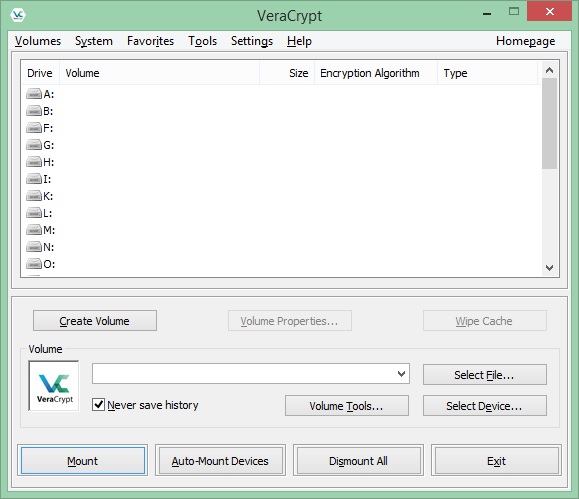

- #VERACRYPT REVIEWS HOW TO#
- #VERACRYPT REVIEWS MAC OSX#
- #VERACRYPT REVIEWS INSTALL#
- #VERACRYPT REVIEWS WINDOWS 10#
- #VERACRYPT REVIEWS SOFTWARE#
… but be sure not to Save the machine state (as saving complicates the next step).ĩ. Yay! Once it boots up, you are running your new OS inside a Virtual Machine! Close it down… In the VirtualBox Manager screen, select your newly created Virtual Machine, then hit "Start”. Be sure to save the virtual drive file in your mounted hidden folder. Hit "Create”.Ħ. You can leave maximum file size high for the same reason (although some people recommend setting it just slightly smaller than the space reserved for your hidden volume). Remember that its maximum size will anyway be limited by the space that you allocated for your hidden folder Stick with the defaults unless you have a good reason not toĪ dynamically allocated virtual drive is fine. This step is not strictly necessary, but I will create one for demonstration purposes. You now have the option to create a virtual hard disk. My PC rocks 16 GB of RAM, so I can afford to be generous with my VM!ĥ. The more the better, but it takes away from the RAM available to your primary OS. Choose how much RAM you want the VM OS to use.

Fire up VirtualBox and hit "New” to create a new VM.Ĥ. Ensure that all VeraCrypt volumes are unmounted, then mount the encrypted volume that you just created.īe sure to enter the password for your hidden volumeĢ.
#VERACRYPT REVIEWS INSTALL#
Step B – Install your OS using VM VirtualBox and VeraCryptġ. Ensure that the volume size is large enough to contain both the hidden OS and any decoy files placed in the outer folder. To do this, simply follow the steps outlined in my VeraCrypt hidden volumes guide. Step A – Create a VeraCrypt hidden volume

#VERACRYPT REVIEWS MAC OSX#
Note that it is not possible to run Mac OSX under a VM. An Operating System (I use Linux Mint for this tutorial, but feel free to use your favorite).The latest version of Oracle VM VirtualBox (FOSS).This tutorial assumes that you are familiar with the content of my VeraCrypt & how-to basics and VeraCrypt hidden volumes guides. This is a great way to keep all your computer use very secure (as long as you limit your activity to the VM). In addition to hiding data, a VeraCrypt hidden volume can hide an entire Operating System (OS) running on a Virtual Machine (VN). Please be aware that there are also some potential dangers associated with this. The beauty of this system is that is impossible for an adversary to know (let alone prove) that a second volume actually exists. If you enter the password of the outer volume then you open the outer volume, but if you enter the password of the hidden volume then you open that one instead.

This means that, in addition to creating a "regular” VeraCrypt encrypted volume, you can also create a second "hidden” volume inside it.
#VERACRYPT REVIEWS WINDOWS 10#
VeraCrypt has a variety of bug fixes and supports modern PCs with EFI system partitions, a configuration many Windows 10 PCs use.One of the most ingenious and unique features of VeraCrypt is the ability to create hidden volumes (as is was of TrueCrypt before it). VeraCrypt is a project based on the source code of the old TrueCrypt software, which was discontinued. VeraCrypt handles the encryption in the background, and everything else happens transparently. It can also create encrypted file containers, but we’re focusing on encrypting your system drive here. You use your computer normally after it boots. It’s not complicated to use: After setting it up, you just have to enter your encryption password each time you boot your PC.
#VERACRYPT REVIEWS HOW TO#
RELATED: How to Secure Sensitive Files on Your PC with VeraCrypt It works on Windows 10, 8, 7, Vista, and even XP. VeraCrypt is a free and open-source tool you can use to enable full-disk encryption on any Windows PC. Of course, this doesn’t protect you against malware that attacks your PC while it’s running-just against someone stealing your PC or its hard drive and trying to view your files. Even if someone gains access to your physical hard drive, they’ll need your password (or key file) to actually see what you have on the drive. It scrambles your files into random-looking gibberish and you need a secret key to access them. RELATED: How to Enable Full-Disk Encryption on Windows 10Įncryption is the best way to ensure attackers can’t read your files.
#VERACRYPT REVIEWS SOFTWARE#
If you’d rather not, you can use the free and open-source VeraCrypt software to get full-disk encryption on any version of Windows. Some Windows 10 devices ship with “Device Encryption”, but other PCs require you to pay another $99 to get BitLocker on Windows Pro for full-disk encryption.


 0 kommentar(er)
0 kommentar(er)
